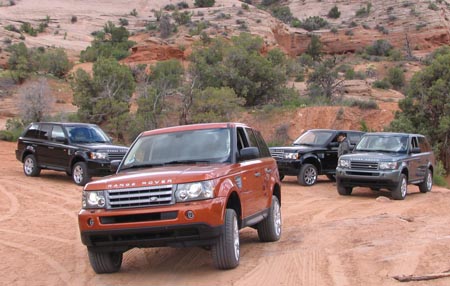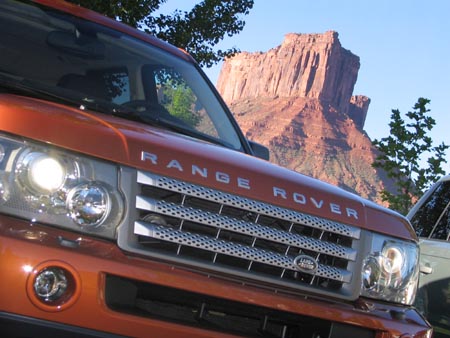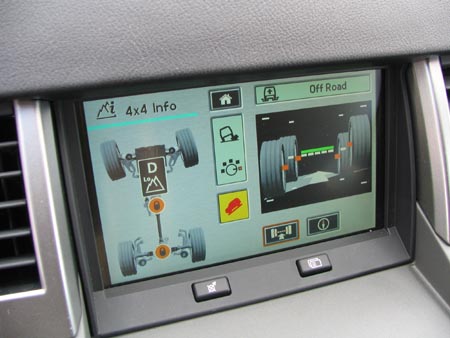“Range Rover Sport is a high-speed, performance-oriented luxury SUV,” Land Rover North America Executive Vice President Richard Beattie said. “As the best driver’s vehicle Land Rover has ever made, it is ideal for fast, comfortable long-distance driving and a fitting compliment to our award-winning Range Rover.”
The Range Rover Sport is a hybrid of sorts – a blending of Land Rover’s LR3 platform and technology with the Range Rover Supercharged powertrain and design detail. It’s a no-brainer that the new Sport model fits into the Land Rover lineup squarely between the two.
Range Rover Sport is offered in two packages – normally-aspirated 300hp HSE or fire-breathing 390hp supercharged. The Sport also features Land Rover’s first application of the new Dynamic Response system – a computer-controlled active antiroll system that senses cornering forces and acts to optimize body control and handling.
We were first introduced to the new Range Rover Sport some time back as we drove from Aspen, Colo., to Moab, Utah. Along the way, the Land Rover team introduced journalists to the many aspects of the Range Rover Sport experience from snow-covered mountain passes to dusty desert trails.
We split time behind the wheel of both HSE and supercharged models getting a taste of each model’s strengths and weaknesses … mostly strengths. In fact the only weaknesses found were a little bit of wind noise at highway speeds, a digital altimeter that does not read higher than 9,990 feet (we maxed that out on a mountain pass in Colorado) and tender sidewalls on supercharged model performance tires that require extra caution when leaving paved surfaces.
We did some serious rock climbing near Moab and had no problem with the tires despite a constant cautionary tone from our driving instructors.
The major styling difference between the Range Rover and Range Rover Sport models is a more pronounced slope of the rear hatch on Sport models – which also have slightly smaller overall dimensions, wheelbase and cargo capacity. The rear hatch is a two-piece design (as on the larger Rover) but in Sport’s case it is a lifting style with the glass opening separately from the rest of the frame.
For the serious offroaders, the Range Rover Sport features Land Rover’s Terrain Response system we first saw in LR3. Terrain Response allows the driver to “dial in” the vehicle’s electronic powertrain components to suit specific offroad driving conditions such as grass/snow, mud/ruts, sand or rock crawl. Throttle response, gear selection, traction and dynamic stability control systems are all affected as well as ABS braking systems. We did get the chance to test a couple of these settings recently with the visit from Old Man Winter (twice) and the mudpit in our back parking lot at work.
While the Range Rover offers slightly better ground clearances offroad, the Sport wins the water fording category with a crossable depth of 27.6 inches – besting the Rover by 8 inches.
Inside, the new Range Rover Sport features more of a “driver’s” cockpit with emphasis on never being boring, tiring or taxing. Where Range Rover has always had the reputation of resonating presence and luxury, Sport is intended to delight and excite owners on the driving experience itself as opposed to the vehicle.
Much of the best on- and offroad technology offered by Land Rover today is shared between the trio of LR3, Range Rover and now Range Rover Sport (not to mention Terrain Response now on the entry LR2). And now Land Rover offers Adaptive Cruise Control which utilizes radar technology to pace distance and speed from vehicles in front for added convenience when back in civilization.
Some of the mechanical and electronic amenities we enjoyed in our Range Rover Sport Supercharged were: four-corner electronic air suspension on independent front and rear suspension components; brembo brakes with all-terrain ABS and cornering brake control; six-speed automatic transmission with sport mode; all-terrain dynamic stability control; front, side and head curtain airbags; heated front and rear windscreens; heated leather sport seating; dual-zone automatic climate control; leather tilt/telescope steering wheel with audio and cruise controls; GPS offroad enhanced navigation system with integrated harman/kardon LOGIC7 surround sound audio system with SIRIUS Satellite radio; adaptive bi-xenon headlamps with front and rear foglamps; park distance control and rear seat DVD entertainment system with dual headrest-mounted monitors.
Pricing for our Sport Supercharged tester begins at $71,175 with the final sticker coming in at $74,550. Fuel economy is rated at 12 mpg city and 18 mpg highway.
Onroad or off, Range Rover Sport is up to the challenge – as are all Land Rover vehicles – and helps solidify Land Rover’s testimony of being “the best 4x4xFar.”







